Adrian Ballinger is used to going big. From ski Mountaineering 25,000 ft peaks in the Himalayas, to finding big wall projects in Yosemite and around the world. Living a life of adventure, Adrian sets out each year to take on 2-3 major projects that will push his body, and leave him feeling fulfilled with what he's accomplished. Heading into a late season 3-week Yosemite climbing trip , Adrian trained his body to meet the demands of the Chouinard-Herbert along the Sentinel Rock. Utilizing his COROS Heart Rate Monitor, COROS VERTIX 2, and COROS VERTIX 2 Carabiner, Adrian was able to track every workout throughout the year. Leading into his his biggest day in Yosemite, Adrian followed a dedicated 3-week build of fitness while in preparing for the ascent of Chouinard-Herbert.

Why Chouinard-Herbert?
Life for Adrian and wife (Emily Harrington) has been a bit more chaotic compared to years past. Having a young child at home, the two of them were unable accomplish as many big projects in 2023 as they are accustomed to. Knowing that he wanted to push himself during his trip, Adrian set his eyes on the Chouinard-Herbert route during their 3-week stay in Yosemite.
Its the last major formation that Emily and I have not done a route on. We have avoided it for a long time because it's hard and it has risks associated with it.
How Adrian Built and Monitored His Fitness
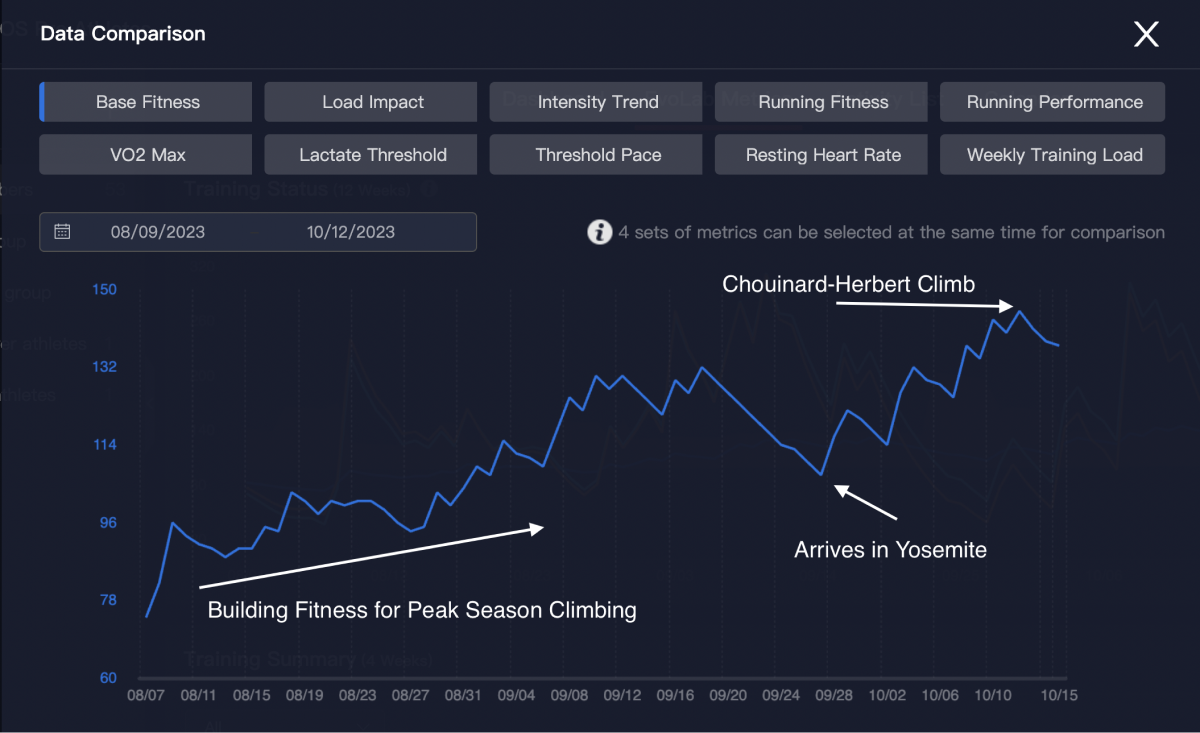
Adrian's Base Fitness as seen in the COROS Training Hub.
COROS Education: Base Fitness looks at your past 42 days of training load. As this line trends up, your overall fitness is improving
In years past, Adrian noted that he would often find himself climbing everyday. "My tendency was to climb every day because I love it so much." However, with the launch of the COROS Heart Rate Monitor, Adrian is now able to get insights into his stress, while still capturing the route, pitches, and elevation with his watch clipped into his carabiner. "Putting big days together with smaller days and incorporating rest as needed has been the key to my effective builds as of late...the data is helping me understand when I need more rest to attempt those larger days."
How COROS Quantifies Training Load (Stress)
Every activity tracked with a COROS watch provides heart rate data. When you add the COROS Heart Rate Monitor as an accessory, it provides data that can be more accurate as the bloodflow within your bicep is stronger compared to your wrist. Based on your heart rate from the activity, combined with the duration of the activity, the COROS App will show you your Training Load associated with that workout. This provides athletes with an easy to understand metric to show how stressful a workout was on their body. Athletes can compare how one activity affected their body compared to others, or, they can look at other metrics such as Base Fitness (long-term fitness) and Intensity Trend (fatigue) which factor in both long-term and recent Training Load figures.
While in Yosemite, Adrian was constantly monitoring his stress levels. Utilizing his COROS app for insights into his recovery, Adrian noted, "On the app I notice when it says training excessively and know I need to take a rest."
Training Heart Rate in Advance

Each Activity Recorded on the Watch Uploads to the COROS App and Training Hub.
Preparing his body to meet the demands of the route, Adrian noted that he had to prepare for 15 total pitches on this route. In the days prior, he would go out and climb 6-10 pitch routes to develop the strength needed. Along with a focus on strength, Adrian is also adamant that he never go above 150 beats per minute with his heart rate. "I’m monitoring my heart rate and trying to keep it below 150 as much as possible. If I go above 150 for any prolonged period, I begin to build lactic acid quickly and could get into a position where I panic. With the Chouinard-Herbert route being dangerous, it was critical that I train this mindset and physical response before getting onto the wall."
Throughout his training leading up, Adrian would use a mix of on-wall data checks, along with reviewing the data afterwards to see how he did. "Its interesting to look at it afterwords, but the key to me while climbing is not to let my hr spike too much. For years, climbers have not worn a watch due to crack climbing or lack of wrist flexibility. With this new device, I just put it on my bicep and forget its even there. It's been a game-changer."
Chouinard-Herbert Climb
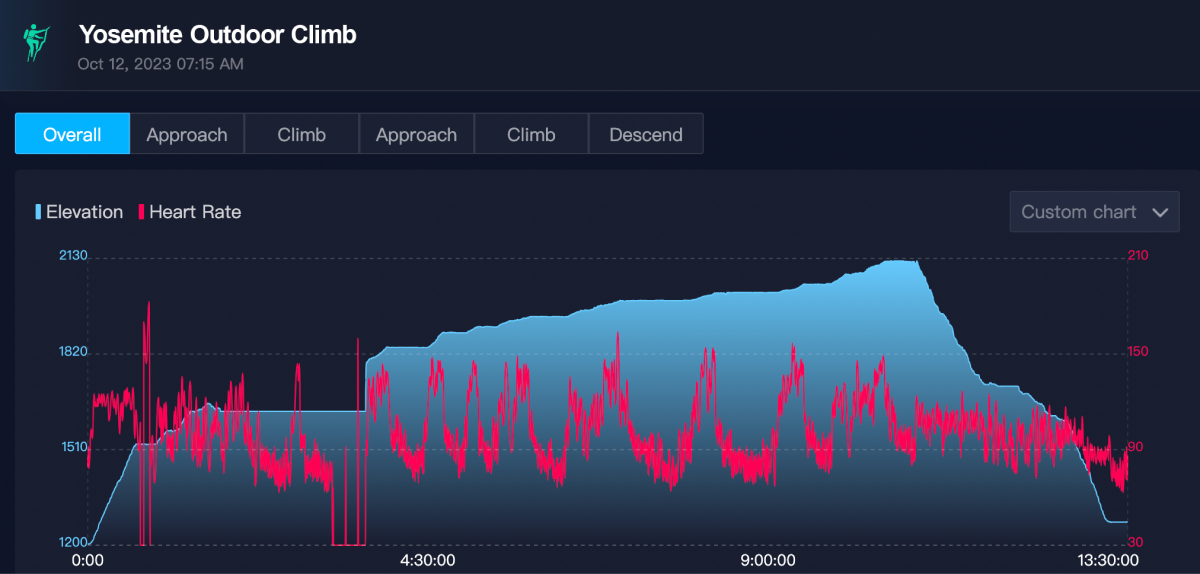
Activity Data can be Analyzed In the COROS App or Training Hub.
Starting the day, Adrian and Emily set out to climb the final big wall on their Yosemite checklist. Having a 2.63 kilometer approach to the climb itself, it took the two of them over 1 hour and 45 minutes to finally locate the route. "It's rarely climbed, as we were going into it, route finding was difficult. 2/3 of the way up, we were unroped, free soloing and trying to find the best way up. On a technical face like this, we were trying to find the correct routes and spent a ton of time trying to find the route. We actually felt being off rope was safer as having a rope in these sections could have caused more risk than necessary."
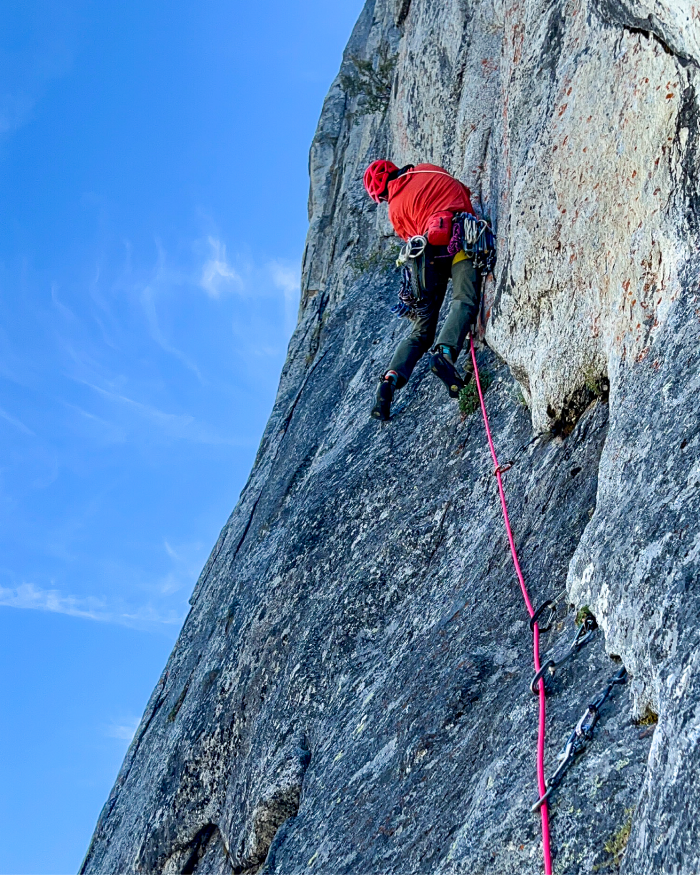
Once on route, Adrian and Emily took a 2-pitch (rope length) on, 1 belay rest cadence. " We would play leapfrog up the wall. One of use would climb up the pitch to where the other was, and then climb another pitch before resting and switching turns. The person belaying would grab our gear, and then climp up and past the other to the next rest point." Following this strategy, you can see from the data above that Adrian was climbing and getting to his comfort level of 150 bpm, and then resting for his recovery portion. Having utilized this tactic in his training, he knew the risk was minimal and he would be able to sustain the 15 pitch, 1400ft wall. "I was really concious of not letting my heart rate elevate. The last thing you want is to experience that pump in your arms while your navigating a dangerous section of rock."
Aiming to complete this route in one day, the two had to manage both time and risk accordingly. " Some of the most dangerous pitches were near the top, so going slow to minimize risk, but also going fast enough to get up before dark. We had to get home before daylight and the descent is dangerous, so we were trying to balance this." Following the top of the climb, the two began the descent in the dark. Having free-solo'd portions of the climb due to the technical nature of it, they ultimately relied on repelling due to the risk associated with the descent in the dark. "It got dark and we got lost on the descent, so we were trying different options and ultimately repelled because we couldn’t down climb in the dark."
When it was all said and done , Adrian and Emily had crossed off their last big project in Yosemite. Having climbed the Chouinard-Herbert route, the two are now taking some downtime to enjoy time with family and plan their upcoming projects for 2024. By utilizing a dedicated training strategy, and monitoring the stress on his body, Adrian was able to take his training into action, and conquer this last big project on his Yosemite to-do list.
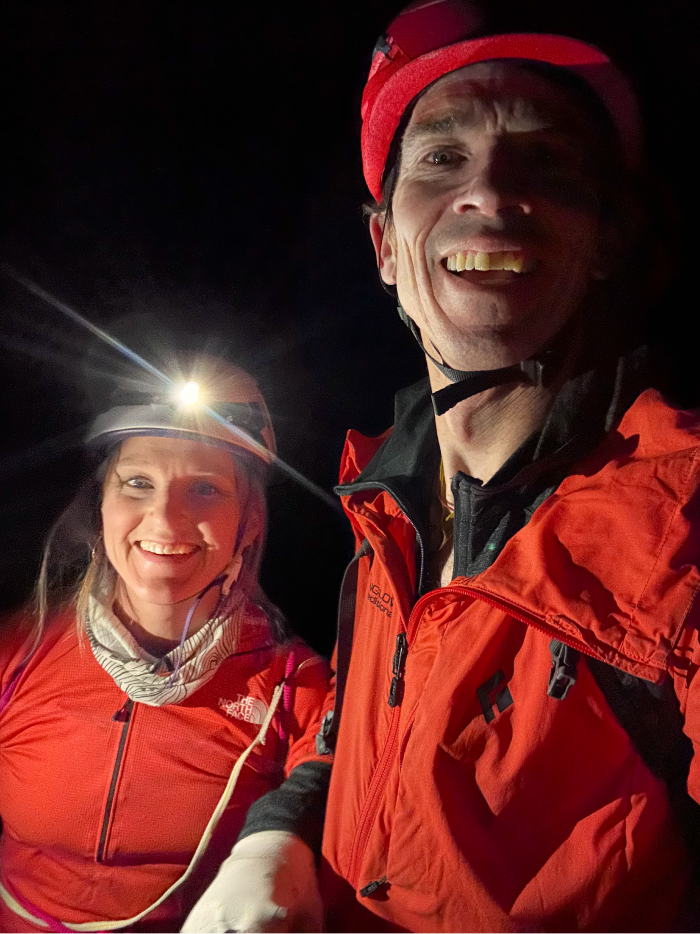
COROS Heart Rate Monitor
COROS launched the arm Heart Rate Monitor in summer of 2023. Recently named one of Time Magazines "Best Inventions", it is proving to solve a huge painpoint for climbers. Adrian was able to train by heart rate for the bulk of his 2023 summer which led him to knowing his fitness, and exactly what he could do on a 15-pitch technical route. Having reflected on what this data means to him, Adrian noted "I'm able to see my data in real time on a pitch, and throughout the days and season. I don’t even have to think about it.. It's just on my bicep every damn day and it's a total game changer for rock climbers. While I am used to heart rate for running or my alpine adventures, I could've never done this climbing with a chest heart strap. Chest straps are uncomfortable and slip, but this product is amazing!"
If you're looking to train in the gym for your next big event, or push your limits in the outdoors, COROS is here to help you improve. By tracking your data, you're able to make better decisions when it counts. Start tracking your data today, and let COROS join you on your next big adventure!
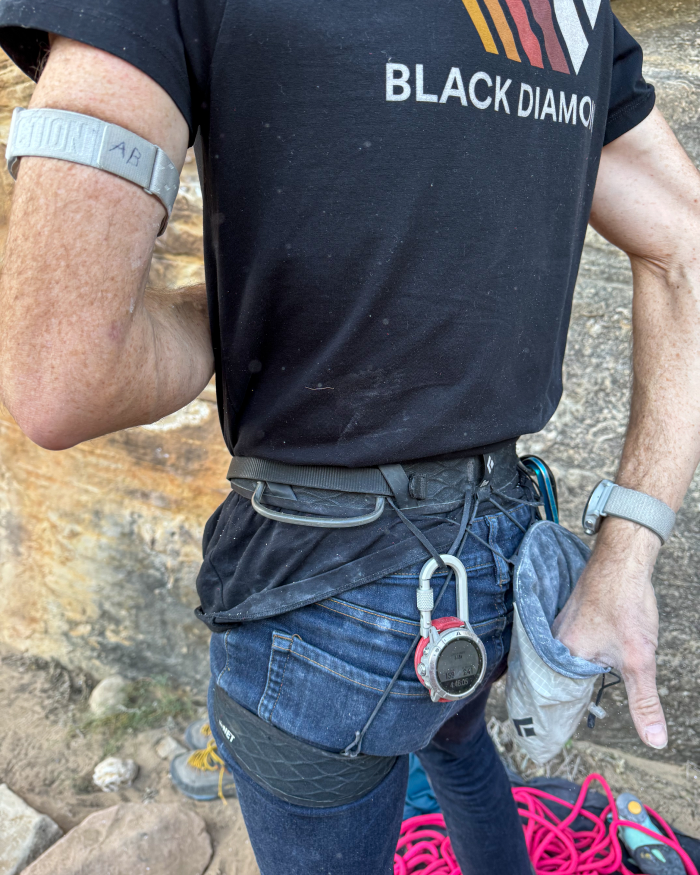
From a recent climbing trip in Sardinia, Italy.
/fit-in/0x18/coros-v2/images/common/logo_black.png)